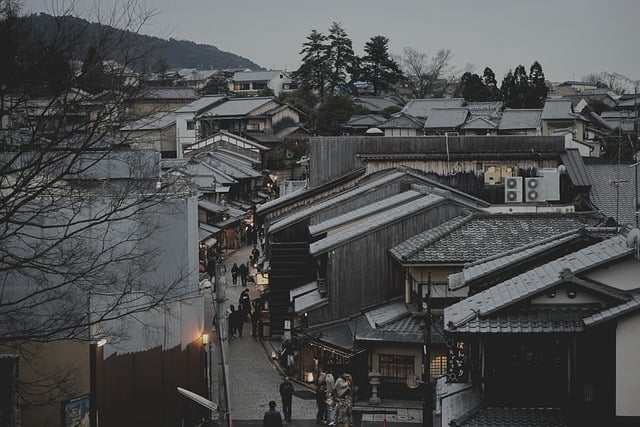-
Table of Contents
- Exploring the Rich History of Kyoto National Museum
- Unveiling the Treasures: A Guide to Kyoto National Museum’s Collections
- The Architectural Marvels of Kyoto National Museum
- Discovering the Cultural Significance of Kyoto National Museum
- A Journey Through Time: Kyoto National Museum’s Exhibitions
- The Influence of Kyoto National Museum on Japanese Art and Culture
- Hidden Gems: Lesser-Known Artifacts at Kyoto National Museum
- Preserving Japan’s Heritage: Conservation Efforts at Kyoto National Museum
- Experiencing Tradition: Events and Activities at Kyoto National Museum
- Q&A
Preserving Japan’s Cultural Heritage.
The Kyoto National Museum is a prominent cultural institution located in Kyoto, Japan. It is one of the oldest and most esteemed museums in the country, dedicated to preserving and showcasing Japan’s rich cultural heritage. With its vast collection of artworks and artifacts, the museum offers visitors a comprehensive insight into the history, art, and traditions of Japan.
Exploring the Rich History of Kyoto National Museum
Kyoto National Museum is a treasure trove of Japan’s rich history and cultural heritage. Located in the Higashiyama district of Kyoto, this museum is a must-visit for anyone interested in exploring the country’s past. With its extensive collection of artifacts and artworks, the museum offers a fascinating journey through time.
One of the highlights of the Kyoto National Museum is its collection of Buddhist art. The museum houses a vast array of Buddhist statues, paintings, and scriptures, showcasing the evolution of Buddhist art in Japan. From the early Heian period to the Edo period, visitors can witness the development of different artistic styles and techniques. The serene beauty of these artworks is truly captivating, and it provides a glimpse into the spiritual and artistic traditions of Japan.
In addition to Buddhist art, the museum also features a remarkable collection of Japanese ceramics. Kyoto has long been renowned for its pottery and porcelain, and the museum’s collection reflects this rich tradition. From delicate tea bowls to intricately designed vases, the ceramics on display demonstrate the skill and craftsmanship of Japanese potters throughout the centuries. Visitors can learn about the different kilns and techniques used in the production of these ceramics, gaining a deeper appreciation for this ancient art form.
Another fascinating aspect of the Kyoto National Museum is its collection of samurai armor and weapons. Samurai warriors played a significant role in Japan’s history, and their armor and weapons are a testament to their bravery and skill. The museum showcases a wide range of armor sets, helmets, swords, and other weapons, allowing visitors to understand the evolution of samurai warfare. The intricate details and craftsmanship of these artifacts are truly remarkable, and they provide valuable insights into the lives of these legendary warriors.
The museum also offers temporary exhibitions that further enrich the visitor’s experience. These exhibitions cover a wide range of topics, from traditional Japanese crafts to contemporary art. By showcasing different aspects of Japanese culture, these exhibitions provide a comprehensive view of the country’s artistic and historical heritage. Visitors can immerse themselves in the vibrant world of Japanese art and gain a deeper understanding of its significance.
To enhance the visitor’s experience, the Kyoto National Museum also offers various educational programs and guided tours. These programs cater to different age groups and interests, providing a more interactive and engaging experience. Whether it’s a workshop on traditional Japanese calligraphy or a guided tour of the museum’s highlights, these programs allow visitors to delve deeper into the rich history and culture of Japan.
In conclusion, the Kyoto National Museum is a treasure trove of Japan’s rich history and cultural heritage. With its extensive collection of Buddhist art, ceramics, samurai artifacts, and temporary exhibitions, the museum offers a comprehensive view of the country’s artistic and historical traditions. Whether you are a history enthusiast or simply curious about Japanese culture, a visit to the Kyoto National Museum is an enriching and enlightening experience.
Unveiling the Treasures: A Guide to Kyoto National Museum’s Collections
Kyoto National Museum is a treasure trove of Japanese art and culture, housing a vast collection that spans over a thousand years. As one of Japan’s oldest and most prestigious museums, it offers visitors a unique opportunity to delve into the rich history and artistic heritage of the country. In this guide, we will take you on a journey through the museum’s collections, unveiling the treasures that await you.
The museum’s collection is divided into several categories, each representing a different period or theme in Japanese history. One of the highlights is the Buddhist Art Gallery, which showcases exquisite sculptures, paintings, and artifacts from the Heian period. These masterpieces offer a glimpse into the spiritual and artistic traditions of ancient Japan, with their intricate details and serene expressions.
Moving on to the Edo period, the museum’s collection of ukiyo-e prints is truly remarkable. These woodblock prints depict scenes from everyday life, kabuki theater, and famous landscapes, capturing the vibrant and dynamic culture of the time. The works of renowned artists such as Hokusai and Hiroshige are on display, allowing visitors to appreciate their skillful craftsmanship and unique artistic vision.
For those interested in traditional Japanese crafts, the museum’s Craft Gallery is a must-visit. Here, you can admire delicate ceramics, lacquerware, textiles, and metalwork, all meticulously crafted by skilled artisans. These objects not only showcase the technical prowess of their creators but also reflect the aesthetic sensibilities and cultural values of the time.
Another section of the museum that shouldn’t be missed is the Archaeology Gallery, which presents a fascinating glimpse into Japan’s prehistoric past. From ancient pottery and tools to burial mounds and artifacts, this collection sheds light on the lives and customs of Japan’s earliest inhabitants. It is a testament to the enduring human spirit and the continuous evolution of society.
In addition to its permanent collections, Kyoto National Museum also hosts special exhibitions throughout the year, offering visitors a chance to explore specific themes or artists in greater depth. These exhibitions often feature loans from other museums and private collections, providing a unique opportunity to see rare and valuable artworks that are not usually on display.
To enhance your visit, the museum offers audio guides in multiple languages, providing detailed explanations and insights into the artworks. Additionally, there are regular guided tours led by knowledgeable staff members who can answer any questions you may have. The museum also has a library and a shop where you can purchase books, prints, and other souvenirs related to the collections.
As you explore Kyoto National Museum, you will be immersed in the beauty and depth of Japanese art and culture. From ancient Buddhist sculptures to vibrant ukiyo-e prints and exquisite crafts, the museum’s collections offer a comprehensive overview of Japan’s artistic heritage. Whether you are a seasoned art enthusiast or simply curious about Japanese history, a visit to this prestigious institution is sure to be a rewarding and enlightening experience.
The Architectural Marvels of Kyoto National Museum
The Kyoto National Museum is a treasure trove of Japanese art and culture. Located in the Higashiyama district of Kyoto, this museum is not only renowned for its vast collection but also for its stunning architecture. The architectural marvels of the Kyoto National Museum are a testament to the rich history and craftsmanship of Japan.
One of the most striking features of the museum is its main building, known as the Meiji Kotokan. Built in 1895, during the Meiji period, this building is a perfect blend of traditional Japanese and Western architectural styles. The Meiji Kotokan is a two-story wooden structure with a distinctive red brick facade. Its elegant design and intricate detailing make it a true masterpiece.
As you enter the Meiji Kotokan, you are greeted by a spacious central hall, which serves as the main exhibition space. The hall is adorned with beautiful wooden beams and pillars, showcasing the traditional Japanese carpentry techniques. The natural light streaming in through the large windows creates a serene and inviting atmosphere, perfect for appreciating the art on display.
Adjacent to the central hall is the Shishinden, a smaller building that houses the museum’s collection of Buddhist art. The Shishinden is a replica of the imperial audience hall of the Heian period, known for its grandeur and opulence. The building features a high-pitched roof, adorned with intricate carvings and gold leaf decorations. Inside, you will find a collection of Buddhist statues, paintings, and artifacts, providing a glimpse into the spiritual and artistic traditions of Japan.
Another architectural gem within the museum complex is the Heisei Chishinkan Wing. Designed by renowned architect Yoshio Taniguchi, this modern addition seamlessly blends with the traditional buildings while adding a contemporary touch. The Heisei Chishinkan Wing houses the museum’s collection of modern and contemporary art, showcasing the evolution of Japanese artistic expression over the years.
The design of the Heisei Chishinkan Wing is characterized by clean lines, minimalist aesthetics, and the use of natural materials such as wood and stone. The spacious galleries provide an ideal setting for displaying large-scale installations and multimedia artworks. The integration of indoor and outdoor spaces creates a harmonious environment, allowing visitors to appreciate the art in a serene and contemplative setting.
In addition to the main buildings, the museum complex also features beautiful gardens and outdoor spaces. The gardens are meticulously landscaped, with carefully placed trees, shrubs, and water features. These tranquil spaces provide a peaceful retreat from the bustling city, allowing visitors to connect with nature and reflect on the art they have experienced.
The architectural marvels of the Kyoto National Museum are not just visually stunning; they also serve a functional purpose. The design of the buildings ensures the preservation and protection of the valuable artworks and artifacts housed within. The use of traditional materials and construction techniques helps maintain the authenticity and integrity of the museum’s collection.
In conclusion, the Kyoto National Museum is not only a repository of Japanese art and culture but also a testament to the architectural brilliance of Japan. The Meiji Kotokan, Shishinden, and Heisei Chishinkan Wing are all architectural marvels that showcase the rich history and craftsmanship of Japan. The integration of traditional and modern elements, along with the beautiful gardens, creates a unique and immersive experience for visitors. Whether you are an art enthusiast or simply appreciate fine architecture, a visit to the Kyoto National Museum is a must.
Discovering the Cultural Significance of Kyoto National Museum

Kyoto National Museum is a cultural treasure that holds immense significance in the history of Japan. Located in the Higashiyama district of Kyoto, this museum is a testament to the rich cultural heritage of the country. With its vast collection of artifacts and artworks, the museum offers visitors a unique opportunity to delve into the depths of Japanese history and appreciate the artistic brilliance of its people.
One of the most remarkable aspects of Kyoto National Museum is its collection of Buddhist art. The museum houses a wide range of Buddhist sculptures, paintings, and calligraphy, showcasing the evolution of Buddhist art in Japan over the centuries. From the serene and graceful statues of the Heian period to the more dynamic and expressive works of the Kamakura period, visitors can witness the transformation of Buddhist art and its influence on Japanese culture.
In addition to Buddhist art, the museum also boasts an impressive collection of Japanese ceramics. Kyoto, being a hub of pottery production, has a long-standing tradition of ceramic craftsmanship. The museum’s collection includes exquisite examples of Kyoto ware, such as Kiyomizu-yaki and Raku ware, which are renowned for their delicate beauty and unique glazes. These ceramics not only reflect the technical mastery of the artisans but also provide insights into the aesthetic preferences of different eras.
Another highlight of the Kyoto National Museum is its collection of traditional Japanese paintings. From the elegant ink brush paintings of the Muromachi period to the vibrant and colorful works of the Edo period, the museum showcases the diverse styles and themes that have shaped Japanese painting. Visitors can admire the meticulous details of the screen paintings and scrolls, which often depict scenes from nature, mythology, or daily life, offering a glimpse into the cultural and social contexts of different periods.
Apart from its permanent collection, the museum also hosts temporary exhibitions that further enrich the visitor’s experience. These exhibitions often focus on specific themes or artists, providing a deeper understanding of various aspects of Japanese art and culture. Whether it is a display of samurai armor, a showcase of traditional textiles, or an exhibition on contemporary Japanese art, these temporary exhibitions offer a fresh perspective and keep the museum dynamic and engaging.
Visiting Kyoto National Museum is not just about appreciating art; it is also an opportunity to immerse oneself in the cultural heritage of Japan. The museum organizes various cultural events and workshops, allowing visitors to experience traditional Japanese crafts firsthand. From tea ceremonies to calligraphy lessons, these activities provide a deeper connection to the art and culture of Japan, fostering a sense of appreciation and understanding.
In conclusion, Kyoto National Museum is a treasure trove of Japanese art and culture. With its extensive collection of Buddhist art, ceramics, and traditional paintings, the museum offers a comprehensive overview of Japan’s artistic heritage. Through its permanent and temporary exhibitions, as well as cultural events, the museum provides a unique and immersive experience for visitors to discover the cultural significance of Kyoto National Museum and gain a deeper appreciation for the rich history and artistic brilliance of Japan.
A Journey Through Time: Kyoto National Museum’s Exhibitions
The Kyoto National Museum is a treasure trove of Japanese history and culture. Located in the Higashiyama district of Kyoto, this museum is a must-visit for anyone interested in exploring the rich heritage of Japan. With its extensive collection of artifacts and exhibitions, the museum offers visitors a unique opportunity to take a journey through time.
One of the highlights of the Kyoto National Museum is its permanent collection, which showcases a wide range of art and artifacts from different periods of Japanese history. From ancient pottery and sculptures to intricate samurai armor and delicate kimono, the museum’s collection provides a comprehensive overview of Japan’s artistic and cultural heritage.
The museum’s exhibitions are carefully curated to provide visitors with a deeper understanding of Japan’s history and traditions. One such exhibition is the “Treasures of the Imperial Household,” which features rare and exquisite objects that were once owned by the Japanese imperial family. This exhibition offers a glimpse into the opulent lifestyle of the royals and provides insights into the country’s imperial history.
Another fascinating exhibition at the Kyoto National Museum is the “Buddhist Art Gallery.” This exhibition showcases a stunning collection of Buddhist statues, paintings, and scriptures, highlighting the profound influence of Buddhism on Japanese art and culture. Visitors can marvel at the intricate details of the statues and immerse themselves in the serene atmosphere of the gallery.
For those interested in traditional Japanese crafts, the museum’s “Crafts Gallery” is a must-see. This exhibition displays a wide range of traditional crafts, including lacquerware, ceramics, and textiles. Visitors can learn about the techniques and skills involved in creating these exquisite crafts and appreciate the beauty and craftsmanship that goes into each piece.
In addition to its permanent collection and exhibitions, the Kyoto National Museum also hosts special exhibitions throughout the year. These temporary exhibitions focus on specific themes or artists and offer a fresh perspective on different aspects of Japanese culture. From contemporary art to traditional performing arts, these special exhibitions provide a dynamic and ever-changing experience for visitors.
The museum also offers various educational programs and events to engage visitors of all ages. From guided tours and workshops to lectures and performances, there are plenty of opportunities to learn and immerse oneself in Japanese culture. The museum’s commitment to education and outreach ensures that visitors leave with a deeper appreciation and understanding of Japan’s rich heritage.
In conclusion, the Kyoto National Museum is a treasure trove of Japanese history and culture. Its extensive collection of artifacts and exhibitions provides visitors with a unique opportunity to take a journey through time. From ancient pottery to contemporary art, the museum showcases the diverse and vibrant aspects of Japanese culture. Whether you are a history enthusiast, an art lover, or simply curious about Japan, a visit to the Kyoto National Museum is an enriching and enlightening experience.
The Influence of Kyoto National Museum on Japanese Art and Culture
The Kyoto National Museum holds a significant place in the history of Japanese art and culture. Established in 1897, it has played a pivotal role in preserving and showcasing the rich artistic heritage of Japan. With its extensive collection of artworks and artifacts, the museum has become a symbol of national pride and a testament to the enduring legacy of Japanese creativity.
One of the key ways in which the Kyoto National Museum has influenced Japanese art and culture is through its exhibitions. The museum regularly organizes exhibitions that highlight various aspects of Japanese art, ranging from traditional to contemporary. These exhibitions serve as a platform for artists to showcase their work and for visitors to gain a deeper understanding of the diverse artistic traditions that have shaped Japanese culture.
Moreover, the museum’s exhibitions often feature collaborations with other institutions and artists from around the world. This not only fosters cultural exchange but also allows for the exploration of new artistic ideas and techniques. By bringing together different perspectives and artistic practices, the Kyoto National Museum has played a crucial role in promoting innovation and pushing the boundaries of Japanese art.
In addition to its exhibitions, the museum also conducts research and conservation efforts to preserve Japan’s artistic heritage. Its team of experts works tirelessly to study and document various art forms, ensuring that they are accurately represented and understood. Through their research, they shed light on the historical and cultural significance of different artworks, providing valuable insights into Japan’s artistic past.
The Kyoto National Museum also actively engages with the public through educational programs and events. It offers workshops, lectures, and guided tours that aim to deepen people’s appreciation and understanding of Japanese art and culture. By making art accessible to a wider audience, the museum has succeeded in fostering a sense of cultural pride and identity among the Japanese people.
Furthermore, the museum’s influence extends beyond its physical walls. Its collection has been digitized, allowing people from all over the world to access and appreciate Japanese art. This digital platform serves as a valuable resource for researchers, students, and art enthusiasts, enabling them to explore Japan’s artistic heritage from the comfort of their own homes.
The Kyoto National Museum’s impact on Japanese art and culture is also evident in the way it has inspired and influenced contemporary artists. Many artists today draw inspiration from traditional Japanese art forms, incorporating elements of it into their own work. This fusion of traditional and contemporary art has resulted in a vibrant and dynamic artistic scene in Japan, with the Kyoto National Museum serving as a catalyst for this creative exchange.
In conclusion, the Kyoto National Museum has had a profound influence on Japanese art and culture. Through its exhibitions, research, educational programs, and digital initiatives, it has played a crucial role in preserving and promoting Japan’s artistic heritage. By fostering cultural exchange and inspiring contemporary artists, the museum continues to shape the artistic landscape of Japan, ensuring that its rich cultural legacy is celebrated and cherished for generations to come.
Hidden Gems: Lesser-Known Artifacts at Kyoto National Museum
Kyoto National Museum is a treasure trove of Japanese art and culture, housing a vast collection of artifacts that span centuries. While many visitors flock to see the museum’s most famous pieces, there are also numerous hidden gems waiting to be discovered. These lesser-known artifacts offer a unique glimpse into Japan’s rich history and artistic traditions.
One such hidden gem is the “Portrait of a Zen Monk” by Tensho Shubun. This exquisite painting, created in the 15th century, captures the essence of Zen Buddhism through its serene and contemplative depiction of the monk. The delicate brushwork and subtle use of color showcase Shubun’s mastery of the ink painting technique, making this artwork a true masterpiece.
Moving on to a different era, the museum also houses a collection of Edo period woodblock prints. While the works of famous artists like Hokusai and Hiroshige often steal the spotlight, there are lesser-known prints that deserve equal attention. One such print is “The Courtesan and the Moon” by Keisai Eisen. This captivating artwork depicts a courtesan gazing at the moon, her elegant kimono adorned with intricate patterns. The print not only showcases Eisen’s skill as an artist but also provides a glimpse into the vibrant nightlife of Edo-era Japan.
Another hidden gem at the Kyoto National Museum is the collection of samurai armor. While the museum’s main exhibition focuses on the armor of famous samurai, there are lesser-known pieces that offer a unique perspective on the samurai culture. One such example is the armor of Honda Tadakatsu, a renowned samurai from the late 16th century. The intricately crafted armor, adorned with gold and silver accents, reflects Tadakatsu’s status as a high-ranking warrior. This artifact not only serves as a testament to the craftsmanship of the armorers but also sheds light on the military prowess and social hierarchy of feudal Japan.
Moving away from traditional art forms, the museum also houses a collection of lacquerware. While lacquerware may not be as well-known as other art forms, it holds a special place in Japanese culture. One standout piece is the “Black Lacquer Tray with Gold Maki-e Design” by Ogata Korin. This stunning tray, adorned with intricate gold designs, showcases Korin’s mastery of the maki-e technique. The use of gold against the black lacquer creates a striking contrast, making this piece a true work of art.
In conclusion, the Kyoto National Museum is not only home to famous masterpieces but also houses a wealth of hidden gems. From the serene Zen painting by Tensho Shubun to the captivating woodblock prints of Keisai Eisen, these lesser-known artifacts offer a unique perspective on Japanese art and culture. The samurai armor and lacquerware collections further enrich the museum’s offerings, providing insights into the military and decorative arts of Japan. So, the next time you visit the Kyoto National Museum, be sure to explore these hidden gems and discover the lesser-known treasures that await you.
Preserving Japan’s Heritage: Conservation Efforts at Kyoto National Museum
Kyoto National Museum is a cultural institution that plays a vital role in preserving Japan’s rich heritage. Located in the heart of Kyoto, this museum is dedicated to the conservation and exhibition of various forms of Japanese art and artifacts. With its extensive collection and commitment to preserving Japan’s cultural legacy, the Kyoto National Museum stands as a testament to the nation’s deep-rooted traditions.
One of the primary objectives of the Kyoto National Museum is to conserve and protect the invaluable artworks and artifacts in its possession. The museum employs a team of highly skilled conservators who work tirelessly to ensure the longevity of these treasures. Through meticulous examination and analysis, they identify the materials used in each piece and develop appropriate conservation strategies.
Conservation efforts at the Kyoto National Museum encompass a wide range of techniques and practices. For instance, delicate paintings on silk or paper are carefully restored using traditional Japanese methods. These techniques, passed down through generations, involve intricate processes such as removing stains, repairing tears, and reinforcing weakened areas. By employing these traditional methods, the museum not only preserves the artworks but also keeps alive the ancient craftsmanship that created them.
In addition to traditional restoration techniques, the Kyoto National Museum also utilizes modern technologies to conserve its collection. Advanced imaging techniques, such as infrared reflectography and X-ray analysis, allow conservators to examine the hidden layers of paintings and detect any underlying damage or alterations. This information is crucial in determining the most appropriate conservation approach for each artwork.
Preserving Japan’s heritage goes beyond the conservation of individual artworks. The Kyoto National Museum also takes great care in maintaining the environmental conditions within its exhibition halls and storage facilities. Strict temperature and humidity controls are implemented to prevent deterioration caused by fluctuations in these factors. Additionally, the museum employs state-of-the-art security systems to safeguard its collection from theft or damage.
The conservation efforts at the Kyoto National Museum extend beyond the walls of the institution itself. The museum actively collaborates with other cultural organizations, both within Japan and internationally, to share knowledge and expertise in the field of conservation. Through these partnerships, the museum contributes to the development of best practices and fosters a global network of professionals dedicated to preserving cultural heritage.
The conservation efforts at the Kyoto National Museum are not limited to preserving physical artifacts. The museum also recognizes the importance of digital preservation in the modern age. It has undertaken extensive digitization projects to create high-resolution images of its collection, making them accessible to a wider audience. This digital archive serves as a valuable resource for researchers, scholars, and art enthusiasts around the world.
In conclusion, the Kyoto National Museum stands as a beacon of Japan’s cultural heritage, with its unwavering commitment to preserving and conserving the nation’s artistic treasures. Through a combination of traditional techniques and modern technologies, the museum ensures the longevity of its collection. By collaborating with other institutions and embracing digital preservation, the Kyoto National Museum actively contributes to the global effort of safeguarding cultural heritage. As visitors explore its halls, they are not only immersed in the beauty of Japan’s past but also witness the dedication and expertise that goes into preserving it for future generations.
Experiencing Tradition: Events and Activities at Kyoto National Museum
Kyoto National Museum is a treasure trove of Japanese art and culture, offering visitors a unique opportunity to immerse themselves in the rich traditions of this ancient city. Beyond its impressive collection of artifacts, the museum also hosts a variety of events and activities that allow visitors to experience tradition firsthand.
One of the highlights of the museum’s event calendar is the annual Kyoto National Museum Exhibition. This exhibition showcases a carefully curated selection of artworks from the museum’s collection, providing a comprehensive overview of Japanese art history. From ancient pottery to contemporary paintings, visitors can witness the evolution of artistic expression throughout the centuries.
In addition to the exhibition, the museum also offers a range of workshops and demonstrations that allow visitors to engage with traditional Japanese crafts. These hands-on activities provide a unique opportunity to learn from skilled artisans and gain a deeper understanding of the techniques and materials used in traditional art forms. Whether it’s trying your hand at calligraphy or learning the intricate process of kimono dyeing, these workshops offer a truly immersive experience.
For those interested in the performing arts, the museum regularly hosts traditional Japanese music and dance performances. These captivating shows feature talented performers who have dedicated their lives to mastering their craft. From the haunting melodies of the shakuhachi flute to the graceful movements of the Noh theater, these performances transport visitors to a bygone era and offer a glimpse into the soul of Japanese culture.
Another popular event at the museum is the Tea Ceremony Experience. Led by a knowledgeable tea master, this intimate gathering allows visitors to participate in the centuries-old ritual of preparing and serving matcha, a powdered green tea. The ceremony is not only a sensory delight but also a reflection of the principles of harmony, respect, and tranquility that are deeply ingrained in Japanese culture.
For those seeking a more interactive experience, the museum offers guided tours led by knowledgeable docents. These tours provide valuable insights into the museum’s collection, highlighting key artworks and their historical significance. The docents’ expertise and passion for Japanese art make these tours a truly enriching experience, allowing visitors to appreciate the cultural context and artistic nuances of each piece.
In addition to its regular events and activities, the museum also collaborates with local communities to organize special exhibitions and cultural festivals. These collaborations not only showcase the diversity of Japanese art and culture but also foster a sense of community and pride among the people of Kyoto.
In conclusion, Kyoto National Museum offers a wealth of opportunities for visitors to experience tradition through its events and activities. From exhibitions that trace the evolution of Japanese art to workshops that allow visitors to try their hand at traditional crafts, the museum provides a truly immersive experience. Whether it’s attending a traditional music performance or participating in a tea ceremony, visitors can gain a deeper appreciation for the rich cultural heritage of Kyoto.
Q&A
1. What is the Kyoto National Museum?
The Kyoto National Museum is a museum located in Kyoto, Japan.
2. When was the Kyoto National Museum established?
The Kyoto National Museum was established in 1897.
3. What is the main focus of the museum’s collection?
The museum’s collection focuses on Japanese art and cultural heritage.
4. How many artworks are housed in the museum?
The museum houses over 12,000 artworks.
5. What are some notable artworks in the collection?
Notable artworks in the collection include national treasures and important cultural properties of Japan.
6. Does the museum have any special exhibitions?
Yes, the museum regularly hosts special exhibitions showcasing various themes and artists.
7. Are there any educational programs offered by the museum?
Yes, the museum offers educational programs for visitors of all ages.
8. Is there a garden within the museum grounds?
Yes, the museum has a beautiful garden called the “Okazaki Canal Garden.”
9. What is the museum’s address?
The museum’s address is 527 Chayacho, Higashiyama Ward, Kyoto, 605-0931, Japan.The Kyoto National Museum is a prominent cultural institution in Japan, dedicated to preserving and showcasing the country’s rich artistic and historical heritage. With its extensive collection of artworks and artifacts, the museum offers visitors a comprehensive understanding of Japanese art and culture. Through its exhibitions, educational programs, and research activities, the Kyoto National Museum plays a vital role in promoting cultural exchange and appreciation. Overall, the museum serves as a valuable resource for both locals and international visitors seeking to explore and learn about Japan’s artistic traditions and history.
![]()








